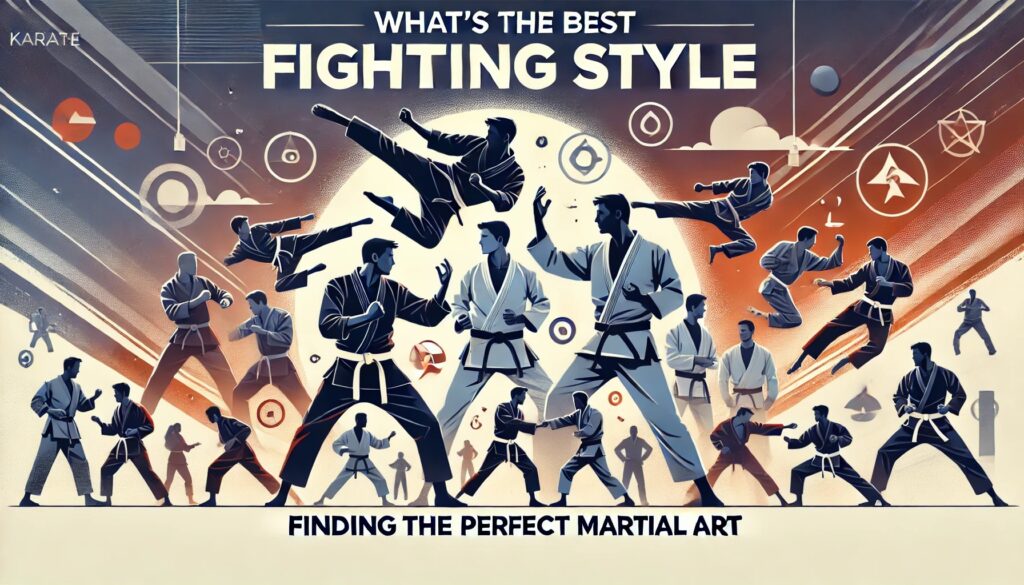
It can prove to be an overwhelming strategy if you decide to pick the best fighting style out of so many. Beyond the unique techniques and philosophies, the special benefits that one is likely to gain from the fighting style make it hard to decide on which fighting style to pursue. Not only may it help you jack up your level of fitness but also in learning self-defense and competing—hence, huge to determine a suitable fighting style. In this article, some popular fighting styles are discussed, including their origin, techniques, advantages, and candidates. By knowing the different characteristics of each style, you can easily determine what is best for you.
What’s the Best Fighting Style?
The best fighting style depends on one’s goals and preferences. For self-defense, Krav Maga and Brazilian Jiu-Jitsu can be the most useful. If you are looking for traditional martial arts that have a rich history yet aggressive training, you may want to consider Karate or Taekwondo. As for health and striking, Muay Thai and Boxing are pretty much at the top of this department. Therefore, evaluate what you need in a fighting style to find the best one that fits you.
What Constitutes the Best Fighting Style?
The definition of “best” in martial arts is subjective and dependent on an individual’s needs or goals within it. For some, it means a fighting style that provides practical self-defense techniques, while others would reply with one that gives them either a physical fitness regimen or competitive opportunities. This section details some criteria by which you can decide exactly what you mean with the question, “What is the best fighting style?”.
Each fighting art has its own strengths and weaknesses. Brazilian Jiu-Jitsu is very dominant on the ground and in terms of submissions; therefore, it would be good for people who like grappling. At the same time, Muay Thai is a very formidable stand-up combat system with oriented strikes in the form of fists, elbows, knees, and shins. Knowing this will help you opt for the right one.
Another could be your physical condition and fitness level. Some martial arts are physically much more challenging than others. Consider MMA, for example. Mixed Martial Arts is a combination of various styles that require quite high endurance levels, strength, and agility. This is in comparison to Tai Chi, which is not particularly a fighting art yet has good health benefits which can be performed at lower speeds, making it accessible to any age.
Personal goals, however, also play a huge role. If your number one concern is self-defense, then Krav Maga would be the best since it deals with real-world situations and effectiveness. If one wants to compete, then other styles like Boxing or Judo offer structured competition environments.
Lastly, consider the availability of training centers and instructors in your area. Some fighting styles may appear perfect on paper, but if you can’t find an accredited instructor or dojo nearby, then it won’t be practical to pursue it.
Popular Fighting Styles Explained
In this section, several popular fighting styles are discussed, concentrating on features that make them unique and beneficial.
Boxing
Boxing is a combat sport orientated around punching techniques. It improves one’s cardiovascular fitness, strength, and hand-to-eye coordination. It is excellent for those interested in developing their striking skills and competing in a controlled environment.
Brazilian Jiu-Jitsu
The Brazilian Jiu-Jitsu emphasizes ground-fighting and submission holds. This martial art, owing to its effectiveness—I particularly in self-defense against larger opponents—is very prominent. Students of BJJ learn how to use leverage and technique to control and submit opponents.
Muay Thai
Muay Thai is a strikings art that decides to make use of all tools at one’s disposal: punches, kicks, elbows, and knees. Its training and conditioning are very tough; thus, it is good for anyone interested in striking and physical fitness.
Krav Maga
Krav Maga is a martial art that was developed for the Israeli military. It removes a lot of the fluff associated with other systems, focusing on real-world scenarios and teaching practical techniques to destroy any threats efficiently. If you want efficiency and effectiveness in self-defense, Krav Maga is the best.
Taekwondo end
Taekwondo is a Korean martial art characterized by its high-flying kicks and fast-faced techniques. Planning and emphasis lay in the field of speed, agility, and alerts, so this will fit one who is looking for something dynamic and competitive in nature.
Benefits of Learning a Fighting Style
Learning a fighting style comes with many more benefits than core self-defense competencies. Some of the major advantages are outlined below.
Physical Fitness: The training is considered to be a full-body workout at the gym, enhancing cardiovascular health, strength, flexibility, and coordination. The different routines used in martial arts—the high-intensity conditioning of Muay Thai or the grappling techniques involved with Brazilian Jiu-Jitsu—make it a full-body workout that shapes overall fitness.
Mental Discipline: Attention, control, and precision go into practice in martial arts, making it related to mental discipline. Training in techniques and forms sharpens focus, discipline, and mental acuity. Other meditation features of martial arts—like breathing exercises and gentle, flowing movements—lessen stress and give more clearness to the mind.
Self-Confidence: As the teachers progress up the ladder of mastering techniques, their self-confidence builds up alongside. Getting to certain milestone grading and rank level promotions give a sense of accomplishment and confidence. This builds into a level of security and a strong sense of assertiveness, which carries over from the dojo into daily life.
Stress Relief: During martial arts training, the physical activity releases endorphins—natural mood elevators. The concentration involved in training offers a mental retreat from the pressure and the hassles of living, hence asserting that the martial arts aspect is an effective avenue for relief from stress and frustration.
Social Connections: Connection to a martial arts class presents ample opportunity for the creation of close bonds between training partners and instructors. This community ensures camaraderie and belonging that one can rely on for a good social environment.
Personal Growth: Martial arts emphasize personal growth through continuous improvement. Starting from the basics and moving on up to advanced levels enforces resilience, patience, and perseverance in a person. The practitioners learn to seize challenges and understand that progress is the end result of effort and dedication.
How to Choose the Best Fighting Style for You?
Choosing the best fighting style involves careful consideration of your goals, physical abilities, and personal preferences. Here’s a detailed guide to help you make the right choice:
- Identify Your Goals: The first step in choosing a fighting style is to determine your primary objective. Are you looking to improve your physical fitness, learn self-defense, compete in tournaments, or simply find a new hobby? Your goals will significantly influence which martial art is best suited for you.
- Assess Your Physical Condition: Different martial arts have varying physical demands. For instance, Brazilian Jiu-Jitsu involves grappling and ground fighting, while Tai Chi focuses on balance and relaxation, which is suitable for all fitness levels.
- Research Different Styles: Understand the basics of styles like Karate, Muay Thai, Boxing, and Krav Maga by watching videos and reading articles. This will help you identify which aligns with your interests.
- Consider Practicality: Think about the practicality of the fighting style in your daily life. Krav Maga and Brazilian Jiu-Jitsu are effective for self-defense, while Muay Thai and Boxing focus on striking. Karate and Taekwondo offer traditional and disciplined approaches.
- Visit Local Dojos or Gyms: Once you have a few styles in mind, visit local dojos or gyms that offer classes. Speak with instructors and observe classes to get a feel for the training environment and teaching methods. Many schools offer trial classes, allowing you to experience the style firsthand before committing.
- Try Out Classes: Take advantage of trial classes offered by martial arts schools. Trying out different styles will give you a better sense of what each one entails and how well it suits your preferences and goals. Pay attention to how you feel during and after the class, and consider whether you enjoy the techniques and training methods.
Conclusion
The best fighting style is the one that aligns with your goals, physical abilities, and interests. Whether you aim to improve your fitness, learn self-defense, or compete, there is a martial art out there for you. Take the time to explore different styles, speak with instructors, and try out classes to find the perfect fit. Remember, the journey in martial arts is as important as the destination, offering valuable lessons and benefits along the way.
FAQ’s
Q. What is the best fighting style for beginners?
A. For beginners, styles like Taekwondo, Boxing, and Brazilian Jiu-Jitsu are great options due to their structured training programs and supportive communities.
Q. How long does it take to master a fighting style?
A. The time required to master a fighting style varies based on the style, individual commitment, and training frequency. It typically takes several years of consistent practice to achieve a high level of proficiency.
Q. Can martial arts help with weight loss?
A. Yes, martial arts training is an effective way to lose weight due to its high-intensity workouts that combine cardio, strength, and flexibility exercises.
Q. Is it possible to learn multiple fighting styles at once?
A. While it’s possible, it’s generally recommended to focus on one style initially to build a strong foundation before cross-training in other styles.








